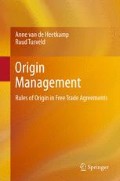Abstract
Trade intelligence provides the exporter and importer with the ability to assess whether or not preferential claims can be made, what the Country of Origin is, and what the duty rate implications are. Trade intelligence includes the Rules of Origin, compliance requirements, documentation, (future) duty rates, and insight into FTA and industry developments. These data are required in an organized/structured format that allows the importer and exporter to make (long-term) business decisions.
Access this chapter
Tax calculation will be finalised at checkout
Purchases are for personal use only
Notes
- 1.
The Information Technology Agreement (ITA) of 1996 was a landmark occasion because of the fact that a specific sector was singled out to benefit from an agreement on import duties. Originally signed by 29 participants, the ITA is in 2008 signed by 70 participants, representing 97% of global trade. As the agreements did include a list of products to be included, with new technology and technology product, governments continue to argue whether specific products are captured under the ITA or not. The arguments mostly evolve around the fact that consumer electronics were not part of the ITA and “computers” were. Since 1996 many new products have hit the market that are hybrids between the classic computers part of the ITA and consumer electronics which are not.
- 2.
Products are typically categorized as part of a particular vertical market. Examples of vertical markets are automotive, textiles, agriculture, consumer electronics, chemicals, medical equipment. The USITC is a system that links HS codes to industries and defines product groups.
- 3.
Since 1990s, a few companies started obtaining unstructured tariff data and providing it to interested parties in structured format. Between 5 and 10 vendors of data or origin-related services currently exist (2009).
- 4.
The New Zealand tariff is one of the exceptions and includes the duty rates per FTA per year on HS-by-HS basis.
- 5.
Data on demand is provided by Trade Intelligence vendors that support a web-based platform and provide Software as a Service (SaaS), a delivery methodology through which also trade data/intelligence can be delivered.
- 6.
This is usually referred to as client–server software. The user installs software from the vendor behind the user’s firewall and uploads updated trade content on a regular basis.
Author information
Authors and Affiliations
Corresponding author
Rights and permissions
Copyright information
© 2011 Springer-Verlag Berlin Heidelberg
About this chapter
Cite this chapter
van de Heetkamp, A., Tusveld, R. (2011). Trade Intelligence. In: Origin Management. Springer, Berlin, Heidelberg. https://doi.org/10.1007/978-3-642-19808-3_8
Download citation
DOI: https://doi.org/10.1007/978-3-642-19808-3_8
Published:
Publisher Name: Springer, Berlin, Heidelberg
Print ISBN: 978-3-642-19807-6
Online ISBN: 978-3-642-19808-3
eBook Packages: Business and EconomicsEconomics and Finance (R0)

